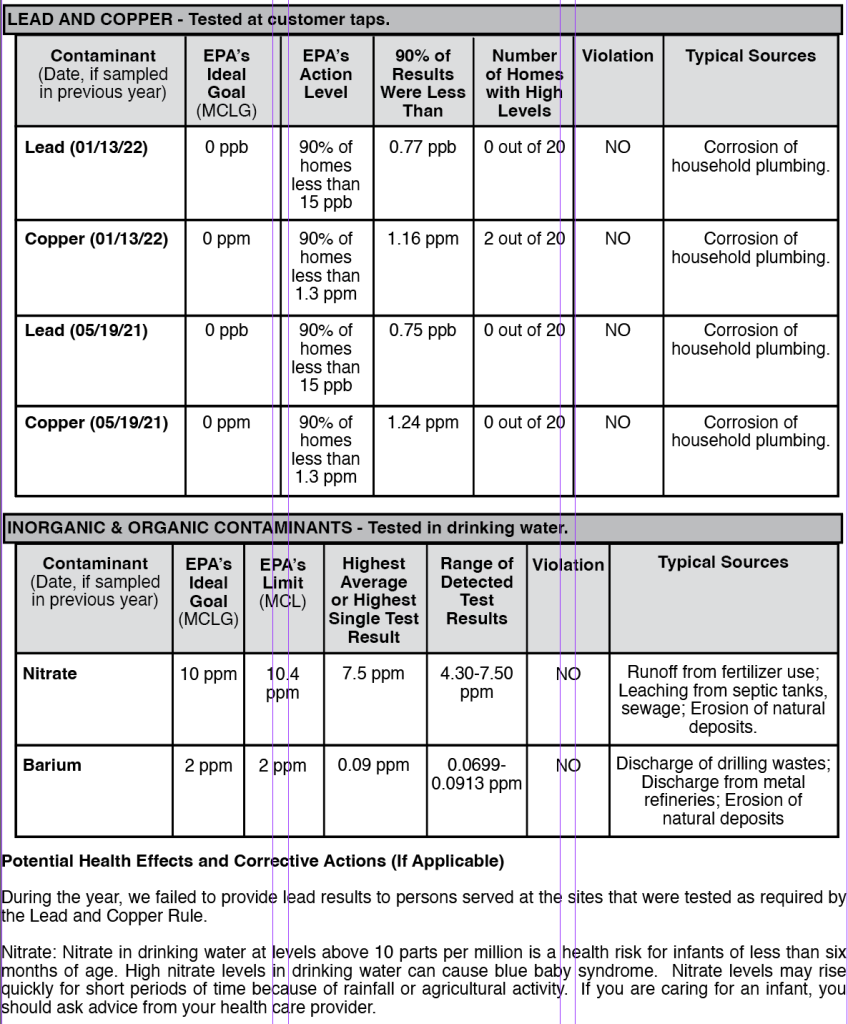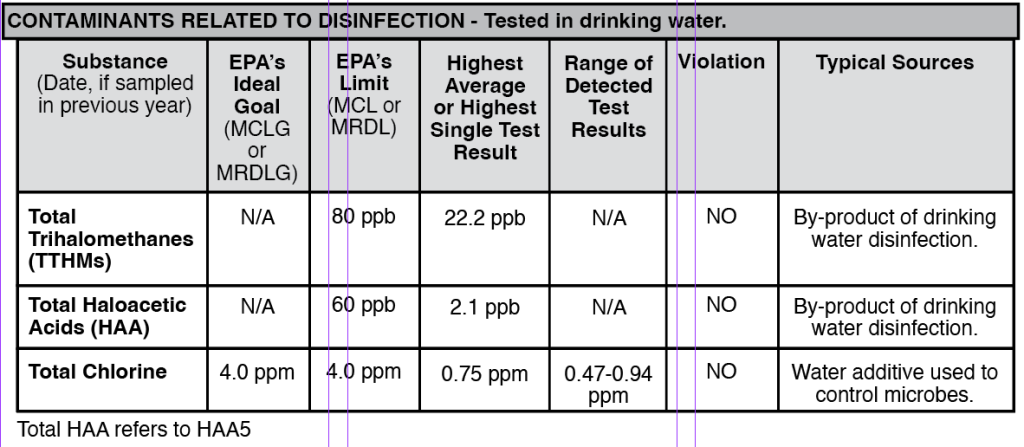CONSUMER CONFIDENCE REPORT
Public Notice | Published on May 2, 2022 at 4:27pm CDT
CONSUMER CONFIDENCE REPORT
City of Glenwood
2021 Drinking Water Report
Making Safe Drinking Water
Your drinking water comes from a groundwater source: two wells ranging from 90 to 108 feet deep, that draw water from the Quaternary Buried Artesian aquifer.
Glenwood works hard to provide you with safe and reliable drinking water that meets federal and state water quality requirements. The purpose of this report is to provide you with information on your drinking water and how to protect our precious water resources.
Contact David Perryman, Public Works Director, at 320-634-5433 or davep@ci.glenwood.mn.us if you have questions about Glenwood’s drinking water. You can also ask for information about how you can take part in decisions that may affect water quality.
The U.S. Environmental Protection Agency sets safe drinking water standards. These standards limit the amounts of specific contaminants allowed in drinking water. This ensures that tap water is safe to drink for most people. The U.S. Food and Drug Administration regulates the amount of certain contaminants in bottled water. Bottled water must provide the same public health protection as public tap water.
Drinking water, including bottled water, may reasonably be expected to contain at least small amounts of some contaminants. The presence of contaminants does not necessarily indicate that water poses a health risk. More information about contaminants and potential health effects can be obtained by calling the Environmental Protection Agency’s Safe Drinking Water Hotline at 1-800-426-4791.
Glenwood Monitoring Results
This report contains our monitoring results from January 1 to December 31, 2021.
We work with the Minnesota Department of Health to test drinking water for more than 100 contaminants. It is not unusual to detect contaminants in small amounts. No water supply is ever completely free of contaminants. Drinking water standards protect Minnesotans from substances that may be harmful to their health.
Learn more by visiting the Minnesota Department of Health’s webpage Basics of Monitoring and testing of Drinking Water in Minnesota (https://www.health.state.mn.us/communities/environment/water/factsheet/sampling.html)
** This consumer report is not being directly mailed to all customers; however, copies are available upon request to City Hall at 320-634-5433**
How to Read the Water Quality Data Tables
The tables below show the contaminants we found last year or the most recent time we sampled for that contaminant. They also show the levels of those contaminants and the Environmental Protection Agency’s limits. Substances that we tested for but did not find are not included in the tables.
We sample for some contaminants less than once a year because their levels in water are not expected to change from year to year. If we found any of these contaminants the last time we sampled for them, we included them in the tables below with the detection date.
We may have done additional monitoring for contaminants that are not included in the Safe Drinking Water Act. To request a copy of these results, call the Minnesota Department of Health at 651-201-4700 or 1-800-818-9318 between 8:00 a.m. and 4:30 p.m., Monday through Friday.
Some contaminants are monitored regularly throughout the year, and rolling (or moving) annual averages are used to manage compliance. Because of this averaging, there are times where the Range of Detected Test Results for the calendar year is lower than the Highest Average or Highest Single Test Result, because it occurred in the previous calendar year.
Definitions
• AL (Action Level): The concentration of a contaminant which, if exceeded, triggers treatment or other requirements which a water system must follow.
• EPA: Environmental Protection Agency
• MCL (Maximum contaminant level): The highest level of a contaminant that is allowed in drinking water. MCLs are set as close to the MCLGs as feasible using the best available treatment technology.
• MCLG (Maximum contaminant level goal): The level of a contaminant in drinking water below which there is no known or expected risk to health. MCLGs allow for a margin of safety.
• MRDL (Maximum residual disinfectant level): The highest level of a disinfectant allowed in drinking water. There is convincing evidence that addition of a disinfectant is necessary for control of microbial contaminants.
• MRDLG (Maximum residual disinfectant level goal): The level of a drinking water disinfectant below which there is no known or expected risk to health. MRDLGs do not reflect the benefits of the use of disinfectants to control microbial contaminants.
• N/A (Not applicable): Does not apply.
• ppb (parts per billion): One part per billion in water is like one drop in one billion drops of water, or about one drop in a swimming pool. ppb is the same as micrograms per liter (μg/l).
• ppm (parts per million): One part per million is like one drop in one million drops of water, or about one cup in a swimming pool. ppm is the same as milligrams per liter (mg/l).
• PWSID: Public water system identification.
Monitoring Results – Regulated Substances



Some People Are More Vulnerable to Contaminants in Drinking Water
Some people may be more vulnerable to contaminants in drinking water than the general population. Immuno-compromised persons such as persons with cancer undergoing chemotherapy, persons who have undergone organ transplants, people with HIV/AIDS or other immune system disorders, some elderly, and infants can be particularly at risk from infections. The developing fetus and therefore pregnant women may also be more vulnerable to contaminants in drinking water. These people or their caregivers should seek advice about drinking water from their health care providers. EPA/Centers for Disease Control (CDC) guidelines on appropriate means to lessen the risk of infection by Cryptosporidium and other microbial contaminants are available from the Safe Drinking Water Hotline at 1-800-426-4791.
Learn More about Your Drinking Water
Drinking Water Sources
Minnesota’s primary drinking water sources are groundwater and surface water. Groundwater is the water found in aquifers beneath the surface of the land. Groundwater supplies 75 percent of Minnesota’s drinking water. Surface water is the water in lakes, rivers, and streams above the surface of the land. Surface water supplies 25 percent of Minnesota’s drinking water.
Contaminants can get in drinking water sources from the natural environment and from people’s daily activities. There are five main types of contaminants in drinking water sources.
• Microbial contaminants, such as viruses, bacteria, and parasites. Sources include sewage treatment plants, septic systems, agricultural livestock operations, pets, and wildlife.
• Inorganic contaminants include salts and metals from natural sources (e.g. rock and soil), oil and gas production, mining and farming operations, urban stormwater runoff, and wastewater discharges.
• Pesticides and herbicides are chemicals used to reduce or kill unwanted plants and pests. Sources include agriculture, urban stormwater runoff, and commercial and residential properties.
• Organic chemical contaminants include synthetic and volatile organic compounds. Sources include industrial processes and petroleum production, gas stations, urban stormwater runoff, and septic systems.
• Radioactive contaminants such as radium, thorium, and uranium isotopes come from natural sources (e.g. radon gas from soils and rock), mining operations, and oil and gas production.
The Minnesota Department of Health provides information about your drinking water source(s) in a source water assessment, including:
• How Glenwood is protecting your drinking water source(s);
• Nearby threats to your drinking water sources;
• How easily water and pollution can move from the surface of the land into drinking water sources, based on natural geology and the way wells are constructed.
Find your source water assessment at Source Water Assessments (https://www.health.state.mn.us/communities/environment/water/swp/swa) or call 651-201-4700 between 8:00 a.m. and 4:30 p.m., Monday through Friday.
Lead in Drinking Water
You may be in contact with lead through paint, water, dust, soil, food, hobbies, or your job. Coming in contact with lead can cause serious health problems for everyone. There is no safe level of lead. Babies, children under six years, and pregnant women are at the highest risk.
Lead is rarely in a drinking water source, but it can get in your drinking water as it passes through lead service lines and your household plumbing system. Glenwood provides high quality drinking water, but it cannot control the plumbing materials used in private buildings.
Read below to learn how you can protect yourself from lead in drinking water.
1. Let the water run for 30-60 seconds before using it for drinking or cooking if the water has not been turned on in over six hours. If you have a lead service line, you may need to let the water run longer. A service line is the underground pipe that brings water from the main water pipe under the street to your home.
• You can find out if you have a lead service line by contacting your public water system, or you can check by following the steps at: https://www.mprnews.org/story/2016/06/24/npr-find-lead-pipes-in-your-home
• The only way to know if lead has been reduced by letting it run is to check with a test. If letting the water run does not reduce lead, consider other options to reduce your exposure.
2. Use cold water for drinking, making food, and making baby formula. Hot water releases more lead from pipes than cold water.
3. Test your water. In most cases, letting the water run and using cold water for drinking and cooking should keep lead levels low in your drinking water. If you are still concerned about lead, arrange with a laboratory to test your tap water. Testing your water is important if young children or pregnant women drink your tap water.
• Contact a Minnesota Department of Health accredited laboratory to get a sample container and instructions on how to submit a sample:
Environmental Laboratory Accreditation Program
(https://eldo.web.health.state.mn.us/public/accreditedlabs/labsearch.seam)
The Minnesota Department of Health can help you understand your test results.
4. Treat your water if a test shows your water has high levels of lead after you let the water run.
• Read about water treatment units:
Point-of-Use Water Treatment Units for Lead Reduction
(https://www.health.state.mn.us/communities/environment/water/factsheet/poulead.html)
Learn more:
• Visit Lead in Drinking Water
(https://www.health.state.mn.us/communities/environment/water/contaminants/lead.html)
• Visit Basic Information about Lead in Drinking Water (http://www.epa.gov/safewater/lead)
• Call the EPA Safe Drinking Water Hotline at 1-800-426-4791. To learn about how to reduce your contact with lead from sources other than your drinking water, visit Common Sources
(https://www.health.state.mn.us/communities/environment/lead/fs/common.html).
Help Protect Our Most Precious Resource – Water
Conservation
Conservation is essential, even in the land of 10,000 lakes. For example, in parts of the metropolitan area, groundwater is being used faster than it can be replaced. Some agricultural regions in Minnesota are vulnerable to drought, which can affect crop yields and municipal water supplies.
We must use our water wisely. Below are some tips to help you and your family conserve – and save money in the process.
• Fix running toilets – they can waste hundreds of gallons of water.
• Turn of the tap while shaving or brushing your teeth.
• Shower instead of bathe. Bathing uses more water than showering, on average.
• Only run full loads of laundry, and set the washing machine to the correct water level.
• Only run the dishwasher when it’s full.
• Use water-efficient appliances (look for the WaterSense label).
• Use water-friendly landscaping, such as native plants.
• When you do water your yard, water slowly, deeply, and less frequently. Water early in the morning and close to the ground.
• Learn more
• Minnesota Pollution Control Agency’s Conserving Water webpage
(https://www.pca.state.mn.us/living-green/conserving-water)
• U.S. Environmental Protection Agency’s WaterSense webpage
(https://www.epa.gov/watersense)
Reduce Backflow at Cross Connections
Bacteria and chemicals can enter the drinking water supply from polluted water sources in a process called backflow. Backflow occurs at connection points between drinking water and non-drinking water supplies (cross connections) due to water pressure differences.
For example, if a person sprays an herbicide with a garden hose, the herbicide could enter the home’s plumbing and then enter the drinking water supply. This could happen if the water pressure in the hose is greater than the water pressure in the home’s pipes.
Property owners can help prevent backflow. Pay attention to cross connections, such as garden hoses.
The Minnesota Department of Health and American Water Works Association recommend the following:
• Do not submerge hoses in buckets, pools, tubs, or sinks.
• Keep the end of hoses clear of possible contaminants.
• Do not use spray attachments without a backflow prevention device. Attach these devices to threaded faucets. Such devices are inexpensive and available at hardware stores.
• Use a licensed plumber to install backflow prevention devices.
• Maintain air gaps between hose outlets and liquids. An air gap is a vertical space between the water outlet and the flood level of a fixture (e.g. the space between a wall-mounted faucet and the sink rim). It must be at least twice the diameter of the water supply outlet, and at least one inch.
• Commercial property owners should develop a plan for flushing or cleaning water systems to minimize the risk of drawing contaminants into uncontaminated areas.
May 2




